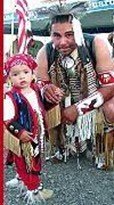Maintaining Indigenous Parenting in a Modern World
By Celeste Halliwell, BBT Indigenous Game Coordinator
“To understand traditional parenting of children, one must firstly understand the Blackfoot ways of knowing and how the indigenous people used to live together as a community of their tribes, their land and animals within the universe” [1].
“Interconnected domains for the developing child” [2]
Elders from the Blackfoot community have emphasized that family cannot be defined within biological parents alone and that parenting roles include an extended family that transcends familial blood lines. Children learn that their community is to be their parenting system and cousin’s may be seen more as siblings [2,3]
Each child is considered a gift from the creator with each child having a meaning that is rooted in their spiritual domain and in line with their culture and people. A Blackfoot elder has stated, “If your children are raised with love, understanding, and patience, they will have that belonging and trust, and the consistency of home and love, bonding and belonging” [2].
Traditionally, fathers were the head of the home, the providers, and responsible for activities related to hunting and fishing for food. Mothers would stay closer to home with the young children and maintain activities such as picking medicinal plants and berries and cooking for her family [4].
The traditional ways of “maintaining their cultural practices, taking care of each tribe member, living in harmony with the land, and minimizing internal and external conflicts are passed through the generations maintaining cultural perpetuity” [4]. In general, indigenous mothers have been known to place greater autonomy and agency in their children, whereas the community engages in children’s competency and mastery of skills. Mothers also provide an emphasis on retaining cultural and spiritual traditions. Teaching children also involved an approach using participation in activities where children would learn alongside mothers as opposed to the Euro-centered approaches of using more speech for teaching children [2,3].
The interruption of traditional family practices through colonization and the Indian Residential School has been noted to bring numerous dysfunctions and maladaptive behaviors in parenting in aboriginal families. Children who attended residential schools were often raised with neglect and abuse and all children did not experience measures necessary for learning healthy parenting [3].
There have been success stories around the Indian Residential School system as some families were able to evade having their children attend residential schools. Blackfoot elders have brought forth how these families have resilience with maintaining their ways of knowing by having a foundation for safety, nurturance and cultural connections that will guide their people to reconnect to their heritage and ancestry. “When children come to know their place and identity in society it gives them self-esteem to have identity and they have pride.” [2].
A revival of indigenous identity in modern times includes important components of protective factors for families; factors such as residence, education and income can provide increasing resilience for indigenous families. Furthermore, having a focus on strengthening protective factors with aboriginal identity, people will have an ability to learn how to meet the challenges in their lives within the larger society [5].
The indigenous family model provides the “optimal conditions for child-rearing which is in a socially fulsome environment where children have access to a relatively large number of parental figures”. Indigenous parenting customs provide natural attachment and cultural attachment among their people that will contribute to healthy brain development and should be revived and maintained for modern day parenting that can begin to reverse some of the maladaptive effects from the Indian Residential School system [3].
Indigenous fathers are considered the most affected from European-centered culture and are most often incarcerated. This has provided a “fissure in the sociocultural transmission of fathers roles across generations” [6].
Many fathers have not grown up with the “experiential learning, affection, and play that have been hallmarks of providing strong role-modeling for their families.” If boys become estranged from their fathers during their developing years, they can have challenges while learning parenting from only one parent; usually their mother. Fathers who become separated from their families often view parenting as a continuous struggle with their children, especially when having few opportunities [6].
Modern programs have been developed for fathers, such as the Aboriginal Head Start program. Modern fathers are reclaiming their roles in families; some by participating in “circles of care” and “kinship care or shared care” as a healing journey to that will enable them to lay strong foundations of “Indigenous Fatherhood” [6].
Reclaiming and maintaining the traditional practices of parenting are necessary for providing a natural protective network for children, teaching them the ways of knowing through an extended family, and incorporating cultural attachment. Traditional practices continue to be considered “a main impetus to developmental learning” for future generations in indigenous communities while residing with European Canadian communities [3].
References
1. Basteine, B. (2004). Blackfoot ways of knowing: the worldview of the Siksikaitsitapi. University of Calgary Press, Calgary, Alberta, 2004. http://hdl.handle.net/1880/49840
2. Lindstrom & Choate. (2016). Nistawatsiman: Rethinking assessment of aboriginal parents for child protection following the Truth and Reconciliation Commission. First People’s Child & Family Review, 11 (2): 45-59. DOI: 10.7202/1082337ar.
3. Lindstrom, G., Choate, P., Bastien, L., Weasel Traveller, A., Breaker, S., Breaker, C., Good Striker, W., and Good Striker, E. (2016). Nistawatsiman: Exploring First Nations parenting: A literature review and expert consultation with Blackfoot Elders. (pg. 11, 12). Calgary, AB: Mount Royal University.
4. Family Culture: The Blackfoot Tribe. (2015). Retrieved online April 2022 from: https://blackfootauhs2015.wordpress.com/
5. Firderes, J. (2008). Aboriginal identity in the Canadian context. The Canadian Journal of Native Studies, XXVIII, 2:313-342.
6. Ball, J. (2009). Fathering in the shadows: Indigenous fathers and Canada’s colonial legacies. Annals of the American Academy, AAPSS, 624: 29-48. DOI: 10.1177/0002716209334181.



